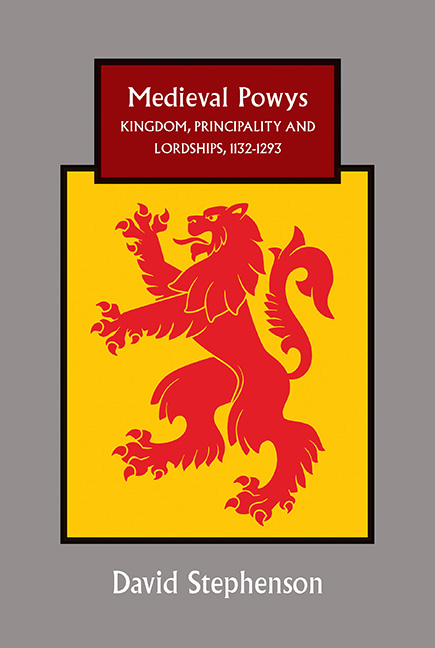Book contents
- Frontmatter
- Dedication
- Contents
- List of Illustrations
- Acknowledgements
- Abbreviations
- Map
- Miscellaneous Frontmatter
- Introduction: The problem of medieval Powys: historiography and sources
- Part I Powysian Polities in the Twelfth and Thirteenth Centuries: A Political Narrative
- 1 The re-emergence of Powys
- 2 The age of eminence: Madog ap Maredudd
- 3 Crisis and renewal: 1160 and its aftermath
- 4 The ascendancy and fall of Gwenwynwyn
- 5 Eclipse: the supremacy of Gwynedd
- 6 Survival: the case of Gruffudd, lord of Bromfield
- 7 Survival: the case of Gruffudd ap Gwenwynwyn
- 8 The persistence of Powysian lordship: Owain ap Gruffudd ap Gwenwynwyn and the descendants of Madog ap Maredudd
- Part II Characteristics of the Powysian Polities: Structures, Fault-Lines and Political Culture
- Appendices
- Select bibliography
- Index
- Miscellaneous Endmatter
2 - The age of eminence: Madog ap Maredudd
from Part I - Powysian Polities in the Twelfth and Thirteenth Centuries: A Political Narrative
Published online by Cambridge University Press: 29 April 2017
- Frontmatter
- Dedication
- Contents
- List of Illustrations
- Acknowledgements
- Abbreviations
- Map
- Miscellaneous Frontmatter
- Introduction: The problem of medieval Powys: historiography and sources
- Part I Powysian Polities in the Twelfth and Thirteenth Centuries: A Political Narrative
- 1 The re-emergence of Powys
- 2 The age of eminence: Madog ap Maredudd
- 3 Crisis and renewal: 1160 and its aftermath
- 4 The ascendancy and fall of Gwenwynwyn
- 5 Eclipse: the supremacy of Gwynedd
- 6 Survival: the case of Gruffudd, lord of Bromfield
- 7 Survival: the case of Gruffudd ap Gwenwynwyn
- 8 The persistence of Powysian lordship: Owain ap Gruffudd ap Gwenwynwyn and the descendants of Madog ap Maredudd
- Part II Characteristics of the Powysian Polities: Structures, Fault-Lines and Political Culture
- Appendices
- Select bibliography
- Index
- Miscellaneous Endmatter
Summary
Madog ap Maredudd succeeded to the kingdom of Powys on his father's death in 1132; he was to rule until his own death in 1160. During that time the Powysian polity became established as one of the major realms of twelfth-century Wales, as the more fluid kingships of the eleventh century were replaced by increasingly defined territorial realms, in each of which a single dynasty, and on occasion a single ruler, held sway. Three great polities in particular emerged as dominant elements in the new configuration of Welsh politics, those of Gwynedd, Deheubarth and Powys, a tripartite division that was emphasised in the texts of Welsh law that were being produced by the close of the century. Each of those realms owed its consolidation to the effort and ambition of one or two great rulers – Gruffudd ap Cynan and his son Owain in the case of Gwynedd, the sons of Gruffudd ap Rhys ap Tewdwr, of whom Rhys ap Gruffudd emerged as by far the most significant, in Deheubarth, and in Powys Maredudd ap Bleddyn and his son Madog.
The bounds of the kingdom to which Madog succeeded were far from fixed, and indeed the whole of his reign was to see constant adjustment of the borders of his territory. Literary sources furnish descriptions of the extent of Powys under Madog. The Powysian prose tale Breudwyt Ronabwy, probably composed in the later thirteenth century, proclaims that ‘Madog ap Maredudd held Powys from end to end, that is from Porffordd to Gwanan in the furthest uplands of Arwystli’. Porffordd is to be identified as Pulford, just five miles to the south-west of Chester, and Gwanan denotes a spot that still marks the boundary between Powys and Ceredigion. A near contemporary of Madog, his poet Gwalchmai, described Madog's realm, with only a little poetic licence, as extending ‘from the summit of Pumlumon to the gates of Chester’, and from the church of Bangor Is Coed (Bangor on Dee) to the forests of Meirionnydd. But one of these sources is late in date, and the other gives us a picture of the extent of Madog's territories at the time of his death, while neither attempts to describe the full area of the kingdom in every direction.
- Type
- Chapter
- Information
- Medieval PowysKingdom, Principality and Lordships, 1132-1293, pp. 39 - 57Publisher: Boydell & BrewerPrint publication year: 2016



